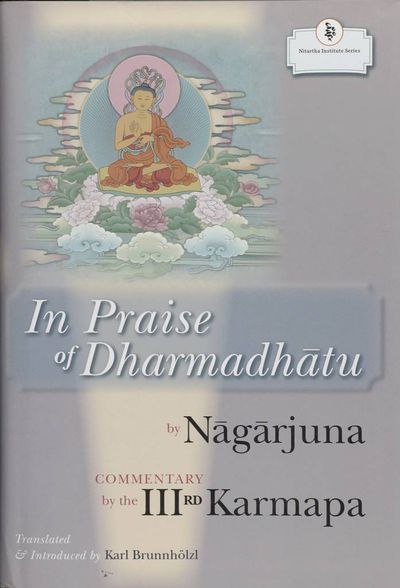No edit summary |
No edit summary |
||
| Line 11: | Line 11: | ||
**{{i|What Did Nāgārjuna Write or Not Write? |22}} | **{{i|What Did Nāgārjuna Write or Not Write? |22}} | ||
**{{i|Various Views on Nāgārjuna's Scriptural Legacy and Its Scope |30}} | **{{i|Various Views on Nāgārjuna's Scriptural Legacy and Its Scope |30}} | ||
**{{i|Who or What Is Praised in Nāgārjuna's Praises? |43}} | **{{i|Who or What Is Praised in Nāgārjuna's Praises?|43}} | ||
*{{i|A Brief "History" of Luminous Mind|57}} | *{{i|A Brief "History" of Luminous Mind|57}} | ||
**{{i|A Terminological Map for the ''Dharmadhātustava'' and Its Commentaries |57}} | **{{i|A Terminological Map for the ''Dharmadhātustava'' and Its Commentaries|57}} | ||
***{{i|The Eight Consciousnesses |57}} | ***{{i|''The Eight Consciousnesses''|57}} | ||
***{{i|The World Is Imagination |59}} | ***{{i|''The World Is Imagination''|59}} | ||
***{{i|Mind Has Three Natures |60}} | ***{{i|''Mind Has Three Natures''|60}} | ||
***{{i|A Fundamental Change of State |63}} | ***{{i|''A Fundamental Change of State''|63}} | ||
***{{i|The Expanse of the Basic Element of Being |63}} | ***{{i|''The Expanse of the Basic Element of Being''|63}} | ||
***{{i|Self-Awareness and Personal Experience |64}} | ***{{i|''Self-Awareness and Personal Experience''|64}} | ||
***{{i|Having the Heart of a Tathāgata |66}} | ***{{i|''Having the Heart of a Tathāgata''|66}} | ||
***{{i|Luminous Mind |67}} | ***{{i|''Luminous Mind''|67}} | ||
**{{i|Luminous Mind and Tathāgatagarbha|68}} | **{{i|Luminous Mind and Tathāgatagarbha|68}} | ||
***{{i|''The Eighth Karmapa on the Dharmadhātu as "Disposition" and Tathāgata Heart'' |83}} | ***{{i|''The Eighth Karmapa on the Dharmadhātu as "Disposition" and Tathāgata Heart''|83}} | ||
***{{i|''Is Buddha Nature an Eternal Soul or Sheer Emptiness?''|102}} | ***{{i|''Is Buddha Nature an Eternal Soul or Sheer Emptiness?''|102}} | ||
*{{i|The ''Dharmadhātustava''|113}} | *{{i|The ''Dharmadhātustava''|113}} | ||
**{{i|An Overview of the Basic Themes of the ''Dharmadhātustava''|113}} | **{{i|An Overview of the Basic Themes of the ''Dharmadhātustava''|113}} | ||
**{{i|Translation: ''In Praise of Dharmadhātu'' |117}} | **{{i|Translation: ''In Praise of Dharmadhātu''|117}} | ||
**{{i|The Significance of the ''Dharmadhātustava'' in the Indo-Tibetan Tradition|130}} | **{{i|The Significance of the ''Dharmadhātustava'' in the Indo-Tibetan Tradition|130}} | ||
*{{i|The Third Karmapa, Rangjung Dorje, and His Commentary on the<br>''Dharmadhātustava'' |157}} | *{{i|The Third Karmapa, Rangjung Dorje, and His Commentary on the<br>''Dharmadhātustava'' |157}} | ||
**{{i|A Short Biography |157}} | **{{i|A Short Biography |157}} | ||
**{{i|Some Preliminary Remarks on Rangjung Dorje's View |159}} | **{{i|Some Preliminary Remarks on Rangjung Dorje's View|159}} | ||
**{{i|On Rangjung Dorje's Commentary on the ''Dharmadhātustava'' |193}} | **{{i|On Rangjung Dorje's Commentary on the ''Dharmadhātustava'' |193}} | ||
**{{i|Other Tibetan Commentaries on the ''Dharmadhātustava'' |198}} | **{{i|Other Tibetan Commentaries on the ''Dharmadhātustava''|198}} | ||
**{{i|Translation of Rangjung Dorje's Commentary|206}} | **{{i|Translation of Rangjung Dorje's Commentary|206}} | ||
*{{i|Appendix I: Outline of Rangjung Dorje's Commentary|307}} | *{{i|Appendix I: ''Outline of Rangjung Dorje's Commentary''|307}} | ||
*{{i|Appendix II: Existing Translations of the Praises Attributed to Nāgārjuna in the Tengyur|310}} | *{{i|Appendix II: ''Existing Translations of the Praises Attributed to Nāgārjuna in the'' Tengyur|310}} | ||
*{{i|Appendix III: Translations of the Remaining Praises|313}} | *{{i|Appendix III: ''Translations of the Remaining Praises''|313}} | ||
*{{i|Glossary: English-Sanskrit-Tibetan | *{{i|Glossary: ''English-Sanskrit-Tibetan''|325}} | ||
*{{i|Glossary: Tibetan-Sanskrit-English | *{{i|Glossary: ''Tibetan-Sanskrit-English''|329}} | ||
*{{i|Bibliography|333}} | *{{i|Bibliography|333}} | ||
*{{i|Endnotes|344}} | *{{i|Endnotes|344}} | ||
Revision as of 17:30, 27 October 2020
Nagarjuna is famous in the West for his works not only on Madhyamaka but his poetic collection of praises, headed by In Praise of Dharmadhatu. This book explores the scope, contents, and significance of Nagarjuna's scriptural legacy in India and Tibet, focusing primarily on the title work. The translation of Nagarjuna's hymn to Buddha nature—here called dharmadhatu—shows how buddha nature is temporarily obscured by adventitious stains in ordinary sentient beings, gradually uncovered through the path of bodhisattvas, and finally revealed in full bloom as buddhahood. These themes are explored at a deeper level through a Buddhist history of mind's luminous nature and a translation of the text's earliest and most extensive commentary by the Third Karmapa Rangjung Dorje (1284–1339), supplemented by relevant excerpts from all other available commentaries. The book also provides an overview of the Third Karmapa's basic outlook, based on seven of his major texts. He is widely renowned as one of the major proponents of the shentong (other-empty) view. However, as this book demonstrates, this often problematic and misunderstood label needs to be replaced by a more nuanced approach which acknowledges the Karmapa's very finely tuned synthesis of the two great traditions of Indian mahayana Buddhism, Madhyamaka and Yogacara. These two, his distinct positions on Buddha nature, and the transformation of consciousness into enlightened wisdom also serve as the fundamental view for the entire vajrayana as it is understood and practiced in the Kagyu tradition to the present day. (Source: Shambhala Publications)
| Citation | Brunnhölzl, Karl, trans. In Praise of Dharmadhātu: Nāgārjuna and the Third Karmapa, Rangjung Dorje. Nitartha Institute Series. Ithaca, NY: Snow Lion Publications, 2007. |
|---|---|



